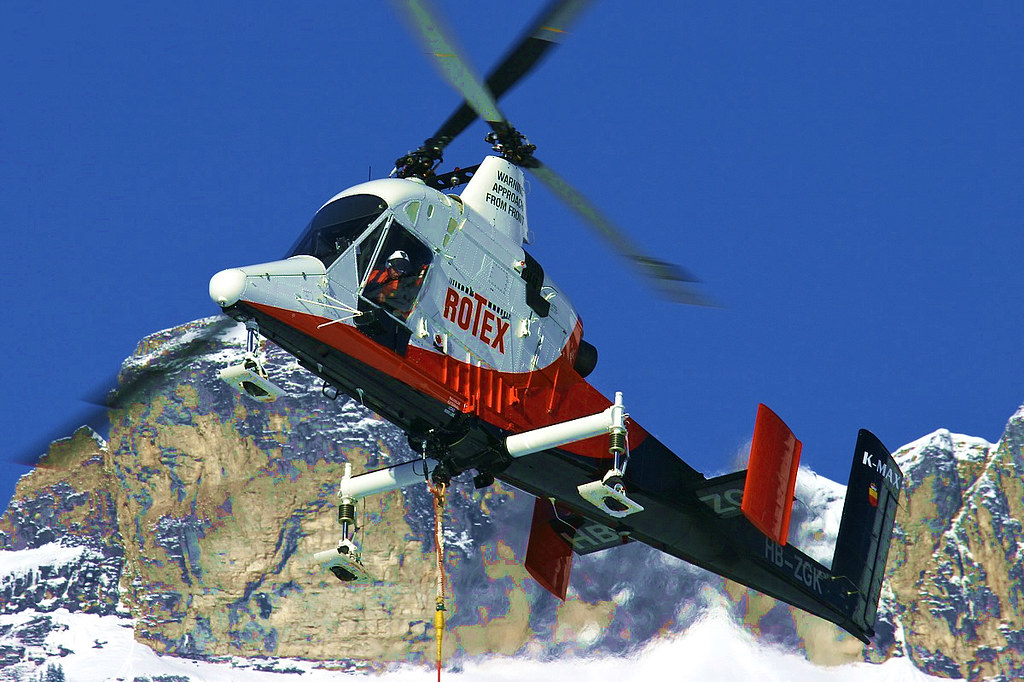Bitmonx: I'm sorry there are (as yet) no replies to your query. However, with fewer than 30 operational examples in existence, K-Max drivers are something of a rarity.
I'm willing to share some speculations with you (and which I know will be a poor substitute for the comments of someone with hands-on experience .. and which comments I hope will come) but, in the meantime ..
The K-Max utilises a contra-rotating and intermeshing main rotor system which was initially developed by the German engineer Anton Fletner (designer of the FL282 Kolibri (1942) .. the helicopter used to make history's first rotary-wing air strike during the Battle of the Bulge). This same design was used on Kaman's H43 Huskie (1947).
One of the features of the K-Max's unique rotor system is that during ground ops one needs to be mindful of the different risk areas .. specifically noting that the area to the sides of the craft is where the rotor swoops lowest (the safe area in most other types).
In terms of handling .. who knows .. except a K-Max pilot but .. I'm willing to guess the following:
That based on the craft's design, downward visibility must be a dream. The fuselage tapers away beneath the pilot's seat giving the craft a 'V' shape profile (from head-on) and which must be an advantage during longline/general lift work.
The K-Max's rotor system would (I imagine) also play a part in assisting pilots during vertical reference flying as the intermeshing arrangement creates a 'dynamic equilibrium' which is inherently stable (as far as I understand it). This stability 'should' make precision work just that bit easier.
Coming to the donk .. you've got a T53-17 producing a galloping 1,400 horses .. being driven into two main rotors both of which are (obviously) providing lift to an airframe with a basic weight of around 2.3 tonnes. What does this mean? Well, I don't truly know but I remember from my days flying the MD530F that when you wanted to execute a maximum performance take-off .. the craft did not disappoint .. it could achieve 2,000fpm in a vertical climb (if required) without reaching torque or temperature limits (in a lightly loaded craft). So .. in the K-Max .. heavens only knows .. 4,000fpm ?? Lol !! On a more practical note .. what it
does mean is that you have a useful load of around 2.7 tonnes, some say slightly more.
This aircraft was, so I understand, specifically designed for external load operations and I think Kaman probably accomplished what they set-out to achieve.
Like you, I'd love to hear some first-hand reviews.
Sadly (and as you probably know) production of the craft ceased in 2003 (nine years after production began). Quite why the K-Max was not more successful .. I am not entirely sure. When I first heard about the project I criticised (like many) the single-place accommodation for the simple reason that it significantly limited the aircraft's multi-role potential. It was explained to me however that if Kaman were to achieve their objective of creating an 'efficient' lifter in this size category .. all excess weight (which obviously included additional cabin accommodation) had to be sacrificed.
In recent years Kaman have found interest in their product from the US Navy (which I think were .. or are .. being used in ship-to-ship re-supply) and the US Marine Corps who have been using unmanned versions of the K-Max to support their operations in Afghanistan.
I hope this powerful little lifter still has a future. Time will tell.
 Kaman K1200 K-Max HB-ZGK as seen in Brienz, Switzerland on 27th November 2008 (Photo: Matias)
Kaman K1200 K-Max HB-ZGK as seen in Brienz, Switzerland on 27th November 2008 (Photo: Matias)